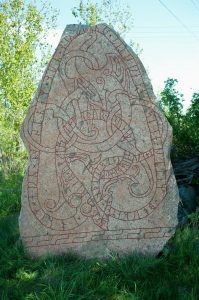J. Richard Judson (William R. Kenan Junior Professor 1974-1993) passed away on June 29, 2020. His former student Jane Carroll (PhD from UNC-Chapel Hill) wrote the below obituary for the Historians of Netherlandish Art. Condolences can be sent to Carolyn (Callie) Judson, 67 Cummings Rd., Hanover, NH 03755.
J. Richard Judson
(July 5, 1925-June 29, 2020)
I first met J. Richard Judson as I sat in a darkened classroom at Smith College. I was seeing art in a new way as Jud led us through a painting. I will talk about his scholarship and disciplinary contributions, but I want to start with a fact that is rarely mentioned—he was an extraordinary teacher. Jud believed in the primacy of the object. Art could be enhanced by cultural information, but the object itself had things to tell. And you could only have that dialogue if you took the time to look deeply at the artwork. He came to class laden with carousels of slides that would move you through a work, detail by detail, as he asked you to draw conclusions. He allowed the art to have a voice and taught us to listen to it.
Jud grew up in New York City, attending Horace Mann School. Upon graduating high school he enlisted with the United States Naval Reserve, serving with them during World War II. Afterward, he enrolled in Oberlin College where he had the good fortune to study under Wolfgang Stechow. They formed a connection and, following Stechow’s retirement, Jud invited him to Smith in 1969 as the William Allan Nielson Chair of Research. In 1953 Jud earned a M.A. from the Institute of Fine Arts at NYU. While at the Institute, he was taught by other foundational art historians such as Craig Hugh Smyth, Walter Friedlaender, and Erwin Panofsky, who served as a Visiting Professor from Princeton. It was also at this time that he met and married Carolyn French Judson. They honeymooned in Brussels, as he liked to say, on the dime of a Belgian-American Educational Foundation grant.
For his Ph.D. in 1956, Jud went to the University of Utrecht to study with scholars of Golden Age Dutch art such as J. G. van Gelder. When choosing a subject for his dissertation, he was asked to select either Hendrick ter Brugghen or Gerard van Honthorst. He told me that he chose Honthorst on the strength of a single painting, the Christ before the High Priest in London, only later to wish he had chosen the other artist. But Honthorst would be the subject of his first book (1959) and of the last volume he wrote, a revision of that early work, with Rudolf E. O. Ekkart discussing the portraits (1999).
His writings were numerous, focusing primarily on sixteenth- and seventeenth-century art from the Low Countries. Jud consistently found riches in the lesser-explored areas of his field, causing scholars to study Northern art more broadly. Notable among his books was Dirck Barendsz. 1534-1592: Excellent Painter from Amsterdam (1970) in which Jud studied the second half of the sixteenth century through the lens of a Dutch artist with ties to Venice. The volume explored the connections that influenced both art and the wider culture. Three years later, in The Drawings of Jacob de Gheyn II, he brought to our attention the superb draughtsmanship of that artist while illuminating Jacob’s output as evidence of contemporary Humanist intellectual trends. Jud’s first volume for the Corpus Rubenianum was Book Illustrations and Title-pages (1978). The richness of that topic, Rubens’ literary visual language, resulted in an exhibition at the Museum Plantin-Moretus in Antwerp, P. P. Rubens als boekillustrator (1977). His second work for that series, The Passion of Christ (2000), explored Rubens’ balance of tradition and innovation in a Post-Tridentine religious world. Between the two Rubens volumes, Jud was part of the team that created the landmark exhibition The Age of Brueghel: Netherlandish Drawings in the Sixteenth Century (1987). With John Oliver Hand, William W. Robinson, and Martha Wolf, Jud created the exquisite catalogue and sensitive scholarship that elevated the study of Northern drawings.
Jud’s scholarship earned him multiple fellowships from Fulbright, Guggenheim, and ACLS, as well as invitations from the American Academy in Rome and the Netherlands Institute for Advanced Studies in Wassenaar. In 1977 he was the recipient of the Rubens medal given by the City of Antwerp.
During the course of a long academic career, Jud taught at two institutions: Smith College for eighteen years, and as the W. R. Kenan Junior Professor at the University of North Carolina at Chapel Hill for nineteen years. With Seymour Slive, Jud was a member of that first generation of American-born scholars who worked on Dutch art. They set out the path for those who have followed.
Once retired, Callie and Jud returned to New England, though they remained loyal to North Carolina basketball. Desiring to be near an academic library, they moved to Etna, New Hampshire, near Dartmouth College and then to the retirement community of Kendal at Hanover. Aside from art and family, Jud’s other passion was sailing, both racing and cruising up the New England coast. He was a member of the Catboat Association, the Wharf Rat Club, and the Nantucket Yacht Club. On Nantucket, he and Callie had a home on what seems to be the perfect name for a road, Easy Street. There they summered for decades with their four children and grandchildren. On Jud’s desk at UNC there were no photos of his family, just a single photo of his boat riding the waves.


